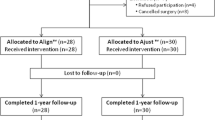Abstract
Introduction and hypothesis
To evaluate the efficacy and safety of the minimally invasive Ajust™ system in the treatment of stress urinary incontinence.
Methods
This was a prospective multicentre study. All patients with primary urodynamic stress urinary incontinence were prospectively selected to receive the Ajust™ procedure. The International Consultation on Incontinence-Short Form (ICI-SF), Women Irritative Prostate Symptoms Score (W-IPSS), PGI-S, and PGI-I questionnaires were used to evaluate the impact of incontinence and voiding dysfunction on QoL and to measure patient's perception of incontinence severity and improvement.
Results
From January 2009 to October 2009, 111 consecutive subjects were enrolled in the study. At 6 months, 102 were available for outcomes analysis. The subjective and objective cure rates were 85.7% and 91.4%, respectively. The ICI-SF and W-IPSS questionnaires showed a statistical significant improvement in symptom scores.
Conclusions
In the short-term follow-up, the Ajust™ system was effective in restoring continence in more than 85% of subjects with a highly significant improvement in QoL.


Similar content being viewed by others
Abbreviations
- SUI:
-
Stress urinary incontinence
- QoL:
-
Quality of life
- SIS:
-
Single incision sling
- MUCP:
-
Maximum urethral closure pressure
References
Moore RD, Serels SR, Davila GW, Settle P (2009) Minimally invasive treatment for female stress urinary incontinence (SUI): a review including TVT, TOT, and mini sling. Surg Technol Int 18:157–173
De Ridder D, Berkers J, Deprest J, Verguts J, Ost D, Hamid D, Van der Aa F (2010) Single incision mini-sling versus transobturator sling: a compatrative study on MiniArc and Monarc slings. Int Urogynecol J 21:773–778
Preclinical study: a rabbit model to evaluate Ajust™ adjustable single incision sling components-12 weeks data. 2009 C.R. Bard, Inc, http://www.accessdata.fda.gov/cdrh_docs/pdf9/K092607.pdf
Tubaro A, Zattoni F, Prezioso D, Scarpa RM, Pesce F, Rizzi CA et al (2006) Italian validation of the International Consultation on Incontinence Questionnaires. BJU Int 97:101–108
Yalcin I, Bump R (2003) Validation of two global impression questionnaires for incontinence. Am J Obstet Gynecol 189:98–101
Tubaro A, Prezioso D, Zattoni F, Artibani W, Pesce F, Scarpa RM, Simoni L [2003] The flow study: validation of four questionnaires on symptoms and quality of life in Italian women with LUTS. In: Proceedings of the International Continence Society, 33rd Annual Meeting, Florence, Italy, 5–9 October 2003
Breivik EK, Bjornsson G, Skovlund E (2000) A comparison of pain rating scales by sampling from clinical trial data. Clin J Pain 16:22–28
Haylen BT, de Ridder D, Freeman RM, Swift SE, Berghmans B, Lee J et al (2010) An International Urogynecological Association (IUGA)/International Continence Society joint report on the terminology for female pelvic floor dysfunction. Int Urogynecol J 21:5–26
Novara G, Galfano A, Boscolo-Berto R, Secco S, Cavalleri S, Ficarra V, Artibani W (2008) Complication rates of tension-free midurethral slings in the treatment of female stress urinary incontinence: a systematic review and meta-analysis of randomized controlled trials comparing tension-free midurethral tapes to other surgical procedures and different devices. Eur Urol 53:288–309
Boyles S, Edwards R, Gregory W, Clark A (2007) Complications associated with trans-obturator sling procedures. Int Urogynecol J 18:19–22
Neuman M (2008) Perioperative complications and early follow-up with 100 TVT- secur procedures. J Minim Invasive Gynecol 15:480–484
Rezapour M, Novara G, Meier PA, Holste J, Landgrebe S, Artibani W (2007) A 3-month preclinical trial to assess the performance of a new TVT-like mesh (TVTx) in a sheep model. Int Urogynecol J 18:183–187
Meschia M, Barbacini P, Ambrogi V, Pifarotti P, Ricci L, Spreafico L (2009) TVT secur: a minimally invasive procedure for the treatment of primary stress urinary incontinence. One year data from a multicentre prospective trial. Int Urogynecol J 20:313–317
Basu M, Duckett J (2010) A randomised trial of retropubic tension-free vaginal tape versus a mini-sling for stress incontinence. BJOG 117:730–735
Schraffordt Koops SE, Bisseling TM, vanBrummen HJ, Heintz PM, Vervest HAM (2006) What determines a successful tension-free vaginal tape? A prospective multicenter cohort study: results from the Netherlands TVT database. Am J Obstet Gynecol 194:65–74
Lim YN, Dwyer P, Muller R, Rosamilla A, Lee J, Kobi S (2010) Do the Advantage slings work as well as the tension-free vaginal tapes? Int Urogynecol J. doi:10.1007/s00192-010-1157-6
Nilsson CG, Palva K, Rezapour M, Falconer C (2008) Eleven years follow-up of the tension-free vaginal tape procedure for treatment of stress urinary incontinence. Int Urogynecol J 19:1043–1047
Ulmsten U, Falconer C, Johnson P, Jomaa M, Lanner L, Nilsson CG et al (1998) A multicenter study of tension-free vaginal tape (TVT) for surgical treatment of stress urinary incontinence. Int Urogynecol J 9:210–213
Waltregny D, de Leval J (2009) The TVT-obturator surgical procedure for the treatment of female stress urinary incontinence: a clinical update. Int Urogynecol J 20:337–348
Conflicts of interest
None.
Author information
Authors and Affiliations
Corresponding author
Rights and permissions
About this article
Cite this article
Meschia, M., Barbacini, P., Baccichet, R. et al. Short-term outcomes with the Ajust™ system: a new single incision sling for the treatment of stress urinary incontinence. Int Urogynecol J 22, 177–182 (2011). https://doi.org/10.1007/s00192-010-1254-6
Received:
Accepted:
Published:
Issue Date:
DOI: https://doi.org/10.1007/s00192-010-1254-6




